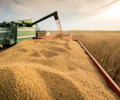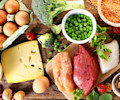Avant Meats Company Limited is a technology company with patent-pending solutions for large scale cultivation of cells at an economically viable cost in an environmentally sustainable way. The company was founded in 2018 and is headquartered in the Hong Kong Science Park.
Applications of the technology include cultivated meat as food. The company’s pilot products are fish meat and fish products that have been tailored for China and other Asian markets. The products are GMO-free, pollutant-free and more nutritious than conventionally produced fish.
Other applications include the production of functional marine proteins that are currently being produced at a high cost. Products are used as ingredients in health supplements, skincare and wound dressing products.
Interview with Carrie Chan and Dr Mario Chin
How is COVID-19 impacting the food industry and, more specifically, meat and dairy consumption? How are food businesses in Asia responding?
Although the long-term effects of COVID-19 have yet to be revealed, our personal views are that in the West, the production and slaughter of animals for food has been deliberately disassociated from consumer minds by the meat industry. In the East, however, freshness is considered very important in Chinese food culture. It is one of the reasons why live animals in cages waiting to be slaughtered is a common scene in marketplaces that are mostly wet and of varied hygiene conditions.
With COVID-19, the concern over the hygiene standards of markets and food safety has been brought to attention. I would not be surprised if people now go more frequently to supermarkets for their groceries. There, they will be more exposed to branded and packaged products. In Hong Kong, supermarkets are like neighbourhood stores. The range of products is relatively limited and hence, people still need to visit wet markets for items such as live fish and seafood. Hypermarkets are more common in mainland China’s top tier cities. They often come with a wet grocery section, which may completely eliminate the need to visit a wet market. These will drive further changes in food businesses in this part of the world.
In your view, how do you think COVID-19 will impact the alternative protein market in China and, more broadly, in Asia? What opportunities do you see for innovative companies like yours, and how has this evolved in the last twelve months?
COVID-19 is like a very effective mass-market education episode on why we need to switch to alternative proteins. In Hong Kong, I would say that the majority of people have heard of Beyond® and Impossible® while a percentage of them, though not high, has tried them. Oatly® has also increased the general awareness of plant-based milk alternatives, with products now available in major coffee shop chains (e.g. Starbucks and Pacific Coffee in Hong Kong). In mainland China, no major coffee shop chains, except Starbucks, provide non-dairy milk alternatives. Only a small number of people in mainland China know about Beyond (Impossible is not yet available to the mainland).
Awareness of both plant-based meat and milk alternatives is mostly driven by brands. Mock meat (which, in China, was previously associated with Buddhism and vegetarianism) and soy milk are very common items in Chinese food culture. In the highly fragmented alternative protein market, the association of plant-based alternatives with the old and dated way of life has not helped to generate interest.
I would say that COVID-19 has prompted the public to consider different options. Beyond®, Impossible® and Oatly® appeared in Hong Kong a few years ago. Market interest has picked up gradually. With COVID-19, these imported brands are highly visible, accessible and have helped re-imagine plant-based meat and milk alternatives in a totally different way, one that allow consumers to associate them with a new lifestyle.
We have seen more plant-based meat options appear on the menus of a growing number of omnivorous restaurants here in Hong Kong. People are increasingly considering alternatives to conventional meat, thus paving the way for cultivated meat. Our product is not yet available in the market, but we are already seeing an increased interest from general investors.
How is the regulatory path for cell-based meat and dairy evolving in Asia? Do you foresee any future challenges?
Same as the rest of the world, mainland China, Hong Kong and Singapore do not have an existing regulatory framework that is applicable for cultivated meat.
Avant was invited to a meeting in Beijing in October 2019, which was organised by the China Plant Based Food Alliance (CBPFA). The key takeaway from the meeting was that China supports the development of the alternative protein industry and sees the need to come up with a regulatory pathway in a timely manner. It was also understood that China would drive the regulations for various forms of alternative proteins suitable for China.
In the case of Hong Kong, it will likely follow other major jurisdictions. For example, US FDA approval (or approval from appropriate statutory bodies of developed economies) is usually regarded as a sufficient determinant of whether a product is fit for consumption. This means that products can be launched in Hong Kong without the need to go through substantial vetting. The implication for Avant is that, if there is applicable legislation in a jurisdiction recognised by Hong Kong, we can launch in Hong Kong using the compliance check achieved in that jurisdiction. This is also the pathway taken by Beyond and Impossible.
Potential challenges are:
time taken to legislate and
details of the regulations.
The time taken to pass legislation is a well-known challenge, though it is also difficult to come up with an appropriate set of regulations to ensure the protection of the public without being overly stringent to the extent that commercialisation becomes infeasible.
As far as cultivated meat is concerned, there is no single standard method of production. The production process is still under development and subject to optimisation, which varies from company to company. For this reason, the risks that need to be assessed and managed differ. Challenges may also arise from the lack of cases on which the drafting of regulations can be based.
There are, of course, pros and cons to prescriptive and non-prescriptive approaches. There will be circumstances to which the prescriptive approach cannot be directly applied. A non-prescriptive approach will make the whole assessment process uncertain, lengthy, potentially in-comprehensive, and even subjective.
There is also a risk that certain steps built into the production process will have to be changed for compliance. Such changes could take a long time to fix and incorporate into the standard operation protocol.
Discussions about the necessity of animal testing have also been had. If animal testing is required, it would be a very tough pill to swallow for companies that seek to eradicate the exploitation of animals.
What about consumer acceptance? How is this changing, and do you think that the Asian consumer is ready for cultivated meat?
According to third-party research, the receptiveness to cultivated meat is comparatively high in China.
Trust in the food supply and regulatory system plays a large part, particularly in this part of the world. At the primary level, people rely on the government for food safety. In China, regulations are stringent and comprehensive. Implementation, enforcement and prevention for such a huge and populace can, however, be highly challenging. Tainted, knockoff and fake products are not uncommon. As a consumer, I fell prey to these products several times.
Because of this, people rely on established brands, both products and distributors, that have proven themselves trustworthy and can provide customers with peace of mind. When it comes to fish, the origins, species, growing conditions and storage conditions are all weak links in the supply chain. Too many things can go wrong, either unintentionally or intentionally, leading to health risks.
We spoke with a number of participants during the Future Food Forum, which was held in Beijing in November 2019. Most of them were enthusiastic or open to the idea of cultivated meat. In our case, for fish, the technology basically consolidates the supply chain to a single process that is highly transparent, traceable, controllable, and clean. This system alone offers a promising solution that provides consumer peace of mind. Of course, participants also asked about flavour, texture, and the price of our pipeline products.
Under mainland China’s one-child policy, most of the young generation is not required to help with household chores. They are more accustomed to a modernised environment and require little persuasion to buy packaged grocery products in supermarkets as opposed to meat cuts at the butchers in wet markets.
The expectation that ingredients need to come from freshly slaughtered animals is gradually being displaced by a greater focus on food safety. This trend helps us when launching our products as branded ingredients in either the foodservice or as packaged products in supermarkets.
What is the company’s strategy to scale up, reduce costs and bring your products to mass market?
Avant Meats started its R&D with cell line development in March 2019. In October 2019, we achieved our first prototype and commenced R&D in cost reduction in late 2019.
Two factors affect cultivated meat production cost:
The cost of the cell culture medium; and
The consumption amount of that medium (which is closely related to the bioprocess).
For cell culture medium, the first step is to replace foetal bovine serum with non-animal-sourced, lower-cost substitutes. The second step is to replace pharma grade ingredients with food-grade ingredients. By June 2020, we reduced the production cost of cell mass to about 40%. We are aiming to reach 10% by early 2021.
We are collaborating with a biologics manufacturer on a medium optimisation project. The aim is to further reduce the cell mass production cost from 10% down to 2-5% by optimising the bioprocess. One approach involves the improvement of the bioreactor design. We are applying for government funding for our new bioreactor design prototype, which we expect to be complete by the end of 2021. Beyond this, economies of scale are expected to contribute to further cost reduction.
By 2021, we are aiming to have a production capacity of several hundred kilograms per year. We reckon that the bioprocess will still need to be further optimised.
In 2022-23, our plan is to reach a production capacity of tens of thousands of kilograms per year. If legislation is completed, we will also acquire approval during this time.
By 2024, we hope to have a well-established and approved production process, developed patents and IP protection measures. Further expansion is to be achieved through technology licensing and/or JV partnerships globally.
We plan to go to market as B2B branded ingredients. We are working with two corporates that are interested in using our technology to produce ingredients for their products. Trademark applications are already underway. By the end of 2020, we will be able to provide samples of our beta product for marketing to corporate customers. We will be releasing a press release with details at that time.
What work has your company done to estimate the resource intensity and environmental impact of your products vis-à-vis conventional meat and dairy products?
In our collaboration project with the biologics manufacturer, we have built data collection into the bioprocess, which includes the recording of water and electricity use. During the pilot production stage, we will monitor and treat by-products of the bioprocess, including spent medium.
During R&D, the use of water and electricity at our lab is recorded, though it is relatively low compared to that of the production stage. A lot of single-use plastic is also used, which is undesirable. The consumption is, however, recorded so that its impact can be assessed.











